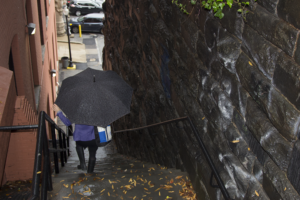The Washington, D.C. Historic Preservation Review Board is set to vote Nov. 15 on an application for the Georgetown Exorcist Steps, an outdoor staircase connecting Prospect Street and M Street, to become a historic landmark.
The Prospect Street Citizens Association filed the proposal Sept. 25 seeking to preserve the steps and adjacent retaining wall because of their historical significance, according to the application.

The steps were originally built in 1895 during the construction of the Car Barn, which was used to store trolley-cars. The 75-step stairway was featured in the 1973 film “The Exorcist,” which was based off the book written by William Peter Blatty (CAS ’50). In the film, one of the priests is depicted falling down the stairs.
The stairs were officially recognized as a tourist destination in 2015 with an official plaque signed by Mayor Muriel Bowser (D), an effort organized by D.C. resident Andrew Huff, according to The New York Times.
Huff expressed his support of the historic landmark proposal.
“I think the steps should get every recognition humanly possible,” Huff said in an interview with The Hoya.
The PSCA submitted the application over concerns of commercial development in the area, PSCA Board Member Catherine Emmerson said in an interview with DCist.
“Our group has long been concerned with any ongoing development activity at 3601 M St., NW,” Emmerson said. “It is our hope that raising awareness about these issues will preserve the Exorcist steps and the retaining wall for all to enjoy for decades to come. It’s too important a fixture in Georgetown to be rubber-stamped by another development-friendly bureaucracy without weighing all the facts.”
The group fears that the construction of condos at the former site of the Exxon Mobil Station on M Street could damage or disrupt the steps. The plans for the condos were conceived in 2013, but developers have faced difficulties in progressing because of Georgetown residents’ concerns, according to Curbed D.C.
Huff expressed his doubt over the effect that a historic landmark designation would have in halting the development of the condos.
“They’re making an effort to either stop or slow down this proposed development with the Key Bridge Exxon,” Huff said. “But from what I understand, this historic designation would not actually impact that proposed development.”
If approved as a historic landmark, any proposed alternation or demolition would require the mayor’s express approval, according to the Historic Landmark and Historic Protection Act of 1978.
Current D.C. historic sites not only include landmarks and districts, but also other sites such as parks and cemeteries, according to the Office of Planning website.
If a property-owner wishes to have a historical designation, then the individual nominating the property must conduct research on the site and consider the level of public interest before submitting an application that can cost from $100 to $1000, according to the Office of Planning website. The Historic Preservation Office then reviews the application within 10 days and sets up a hearing. During the 30-minute hearing, the applicants present their case to the HPRB which then votes on the proposal.
Although Georgetown itself is already a historic neighborhood, the historic landmark designation would provide the Exorcist Steps with additional protections, D.C. Office of Planning Associate Director Edward Giefer wrote in an email to The Hoya.
“The application seeks to recognize the wall and stairs as a landmark on the DC Inventory of Historic Sites and the National Register,” according to Giefer. “In general, this classification brings additional recognition to aspects of historic significance that make these properties individually distinctive above and beyond their being part of a historic neighborhood.”




















